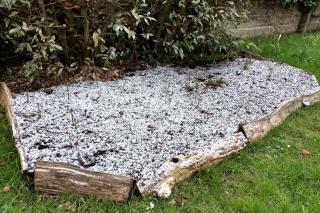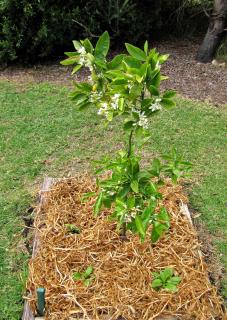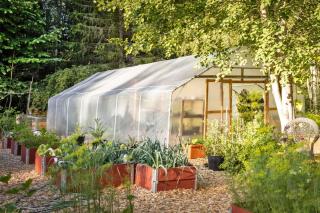

So you splurged and treated yourself to a eucalyptus tree, an oleander, a mimosa tree, a lemon tree or an olive tree? Here is how to protect these plants over the cold season.
Cold-vulnerable plants are usually trees and shrubs, as well as certain flower bed plants. When purchasing your plant, check the label to see what temperatures it should be able to withstand. Some plants, where when winters aren’t too cold, will simply love to wear a few extra “clothes”, while others will have to be uprooted and moved to the cold greenhouse.
“Winter is prepared in fall” is what famed garden masters Brigitte Laouge-Déjean and Denis Pépin advise. They’ve authored a book in French that hasn’t yet been translated to English. Even before the first frost spells hit, in October for example, start getting your equipment ready: this is what you’ll need to protect all parts of the plants: roots, trunk and leaves. Frost won’t win!
For hanging plants or plants in containers, wrap the pot in a large cover and/or bubble wrap. Thick horticultural fleece also does the trick, that’s what it’s designed for. Another option: bury the pot!

“Proscribe from this list any materials that retain water […]. Adequate materials are those that are and will stay dry.”

And they add: “It’s also quite easy to protect small shrubs with an old plastic bag, piece of burlap, or a UV-treated polypropylene winterizing fleece. Even carton/cardboard from a delivery box can be filled with wood chips. Gather the branches of the shrub to tie them into a ball, and wrap the entire plant from stump to tip with straw, hay or leaves. Bring the sac down to engulf the plant, or wrap the plant with the roll of winterizing fleece cut to size.”

Here’s the solution to this conundrum: bring them to a cold greenhouse, a garden shed with windows, windowed cellar, or an “orangerie” if you even want to use the poetic word for this, around mid-October. What’s important is that it must be cool but never freezing, well-lit and well-ventilated. Just as for outdoor plants, limit your watering to as little as you dare to ensure the roots stay intact and don’t rot.
As soon as temperatures rise above 40°F (5°C), take them out for a spin but keep an eye on the weather, and bring them back in if freezing might occur.

However:
“don’t protect your plants too early in fall, or snails and slugs will wiggle into your protective cocoon […]. What’s best: cover it all just before the ground freezes. During winter, make the best of a nice, warmer day to open the packages up and renew air circulation, to eliminate moisture most of all. And then, in spring, remove your protective casings as soon as possible to let the ground warm up.”

Claire Lelong-Lehoang
I’m wondering the best way to winterize a couple plants if anyone has info that would be helpful I’d really appreciate it.
Zonal geraniums
Big leaf hydrangeas
And
Asiatic Lilly/lillium
Thank you
Mandy
PS – All plants will be in the ground.
That’s great! I’m sure your plants will do great!
Hello Gaspard,
Thank you for the kind and prompt reply.
We have polar events here – had three last winter. This winter is predicted to be an El Nino warmer and dryer winter. I hope that proves true. I anticipate our first frost in mid to late October – given the weather prediction of El Nino winter it will likely be the end of October.
I’ll follow your advice and get the bags to cover trees to the ground and mulch three or four inches deep around them. After hard frost and snow if we get a polar event warning I’ll encircle the trees with 48″ snow fence and wrap them in 2 mil plastic. The rhododendrons are advertised as winter hardy but if we get a polar event warning I’ll set stakes by them and wrap them with plastic as well. The Hostas will be losing leaves. I’ll mulch at the drip edges – snow covered they should be safe in polar events.
Thanks again, Shirley
I’m in zone 5 Michigan. We can have brutal weather in Dec and Jan with temps as low as 10 below – factoring wind chill can go to 20 below at night. This is not contentious nights, it happens at intervals. I need to protect a mimosa and a dogwood tree both 5 feet tall which I can put fabric around. Do I need something other than 2 inches of mulch with peat moss to protect my rhododendrons, hydrangeas and hostas I bought recently. All are large potted plants, rhododendrons about 2 feet tall, hydrangeas about a foot tall, hostas the same.
Dear Shirley, it’s great to protect the two taller trees-to-be with fabric or horticultural fleece, they’ll need it, especially since they’re still young. Also mulch atop their roots, too, for added protection.
For the potted plants, you’ll have to do a bit more than just mulch:
10 or 20 below, Fahrenheit, (-20 to -30°C) reaches the limits of rhododendrons and hydrangeas, only few varieties can cope with that. If you purchased them locally, it should be ok. The protections are mostly necessary because they’ve only recently been planted on one hand, and are potted on the other. Potted plants are always more vulnerable.
Don’t let the pots sit in water over the winter, all water must drain out well. And note the leaves will fall off, especially the hostas, but the root system will still sprout back in Spring. Hope this helps!